AWS News Blog
re:Invent 2020 Liveblog: Andy Jassy Keynote
|
|
Jeff Barr‘s liveblog of Andy Jassy’s re:Invent keynote on Dec. 1, 2020 has ended, but you can read all about the event – from Jeff’s perspective – below.
Be sure to follow along with all the top re:Invent announcements here, and we’ll also use this space to keep you posted about other re:Invent liveblogs as they happen!
10:58 AM – And we are done!

The next step is up to you — find some great sessions, watch, learn, and build something awesome!
10:55 AM – A focus on hybrid, Riot Games using AWS Outposts to reduce latency and to create a level playing field for all players.
Redefining and asking what hybrid is all about.

Early hype, and what does on-premises mean? A restaurant, a field?
Customers want a hybrid offering that uses the same tools, APIs, and so forth as their cloud services. Moving workload from on-premises to the cloud using VMware Cloud on AWS. Strong partnership, gaining a lot of steam: doubled number of nodes year-over-year.
Keeping workloads on-premises close to factory or during a transition to cloud? Early solutions had too much friction. Built AWS Outposts, racks of AWS services rolled in. Same APIs, tools, control plane, hardware. Thousands of customers using them.
Customers love Outposts, but they are big racks. Now two new form factors, that take up less space: 1U and 2U servers:

Announced Local Zones last year, launched in LA. Today 3 more in Boston, Houston, and Miami, with 12 more coming in 2021.
AWS in places with no connectivity? Snow Family for poorly connected and rugged locations.
And 5G apps, that need compute, storage, and other infrastructure. Announced AWS Wavelength last year. New locations coming:
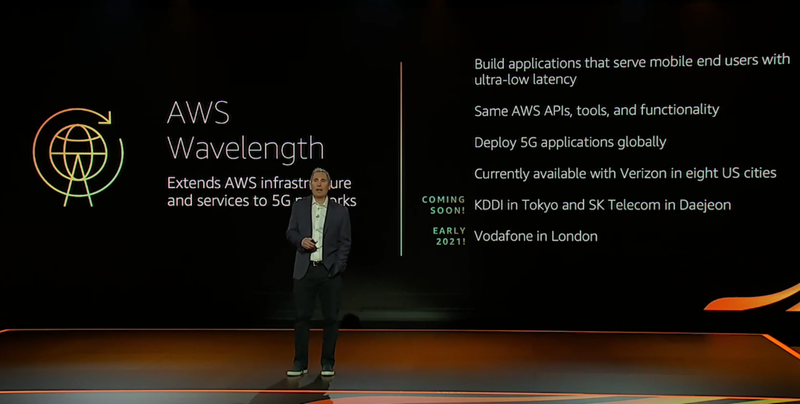
10:38 AM – Desire to use more ML in industry, but need equipment and talent to make it happen.
Monitron – End to end equipment monitoring; sensors, gateway, predictions.
Amazon Lookout for Equipment – Anomaly detection for machinery. Assess sound, vibration, temperature for predictive maintenance.
Computer Vision – AWS Panorama Appliance, connect to existing IP cameras; use prebuilt CV models. And an SDK too!
Use all of this to reinvent your business.
10:30 AM – More reinvention, example is the auto space.

Announcement with Blackberry and Ivy, to build new connected vehicle experiences.
Healthcare, Moderna built and entire suite on AWS to help with COVID-19 vaccine development.
Media and Entertainment, AWS scaled Disney+ to over 70M subscribers in less than a year.
Industrial and Manufacturing, Dave Gitlin from Carrier:

The cold chain and the alliance with AWS.
“Consider a banana.”
2-3 week journey from farm to ocean container, to port, to refrigerated warehouse, to grocery store. Lots of waste, 1/3 of food produced is never consumed, but 1 in 9 people go to bed hungry. So solving the cold chain issue could feed all of them.
Similar issue with pharmaceuticals.
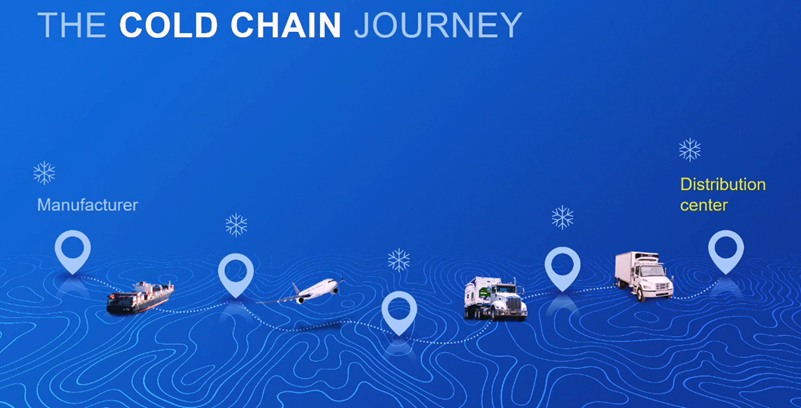
Carrier Lynx is new AWS-powered platform for the cold chain, using IoT and analytics.
Addressing hunger, climate change, and safe vaccine distribution!
10:20 AM – Reinventing broadcasting, Paul Cheesbrough of Fox:

Every vertical application area will be reinvented. Let’s look at call centers! Many are missing two important things: cloud and machine learning. That’s why we built Amazon Connect, a much-loved and fast-growing (thousands of customers) service. Set up in minutes, scales to tens of thousands of agents. Over 5000 companies have used it to spin up call centers during the pandemic.
Now we address some challenges:
Making Product & Customer Info Available to Agents – Amazon Connect Wisdom, with built-in connectors to knowledge repositories. Listens to calls and makes the right info readily available. Also searchable. Amazon Connect Customer Profiles to provide agents with data needed to deliver personalized customer service. Uses order history, contact history, sales, CRM, and other information.
Real-Time Analytics – Identify customer issues in real time during the call using Real-Time Contact Lens.
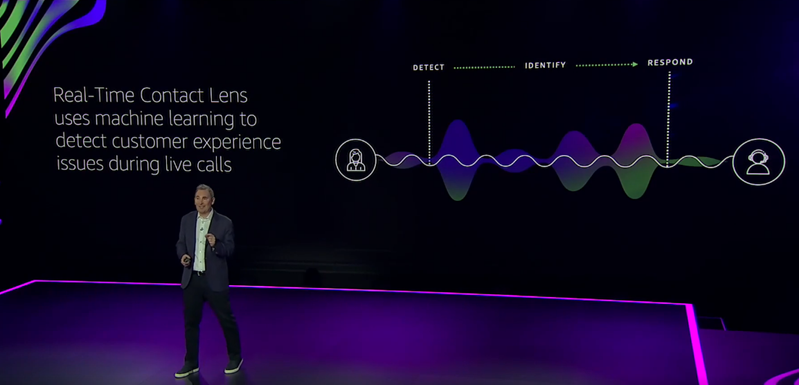
Respond to comments such as “bad experience”, “never using this again” in real time. Fix the issue and maintain the brand.
Optimize Agent Time – Amazon Connect Tasks to track and manage tasks for contact center agents & supervisors; one place to see all tasks. And Amazon Connect Voice ID, real-time caller authentication using ML-powered voice analysis. Customers opt in, say a few sentences to construct a voice print. Then they call in, start talking, and are identified (including a confidence level).
Details on all of these are in this blog post.
9:59 AM – A challenge is trusting results of predictions made by AI services. Expectation that the provider continues to build and to invest.
Amazon CodeGuru is used heavily within Amazon. First for Java and now for Python as well. Also a new Security Detector that provides real-time alerts, and new Amazon DevOps Guru to identify operational issues early:
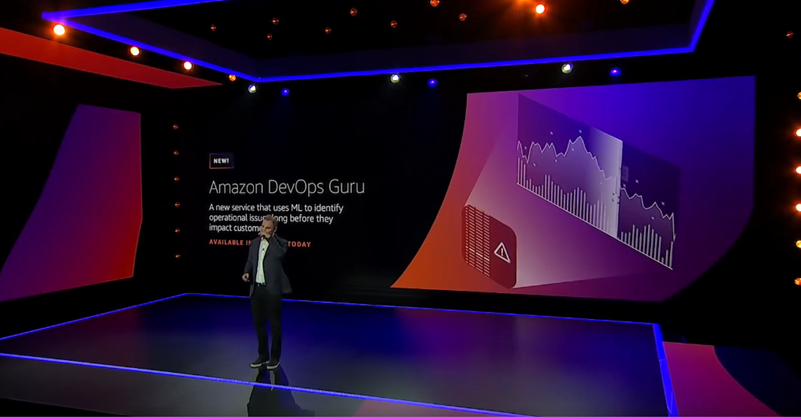
Customers don’t want to have to figure out how to put the pieces together. “Hiring products and services to do a job.” – Clay Christiansen.
Reinventing business intelligence (BI) using ML and natural language to make it easier to get and understand results. That’s why we built Amazon QuickSight. Now we are investing in ML such as automatic narratives to help understand results and key insights.
Customers want this in other aspects of their BI work. Amazon QuickSight Q – Ask any question, get answers in seconds. Trained over many data points and business areas.
9:40 AM – Make no mistake, we are very early in the history of machine learning. PyTorch has caught up with TensorFlow because it is easier to use. Many practitioners use more than one framework.
AWS has more ML capability than anyone else, and we now have a separate ML keynote (next week).
We want to have the right tools for expert ML practitioners, starting with tools and chips. And then on to frameworks, we decided to support all of the major ones, with separate teams for each. We still expect to see new frameworks pop up, and we will support them.
We also need to support everyday developers and data scientists. Amazon SageMaker made it a lot easier, and we added more than 50 capabilities since last year, about one per week. Tens of thousands of customers use it. SageMaker Notebooks, Debugger, Experiments, Model Monitor, Autopilot.
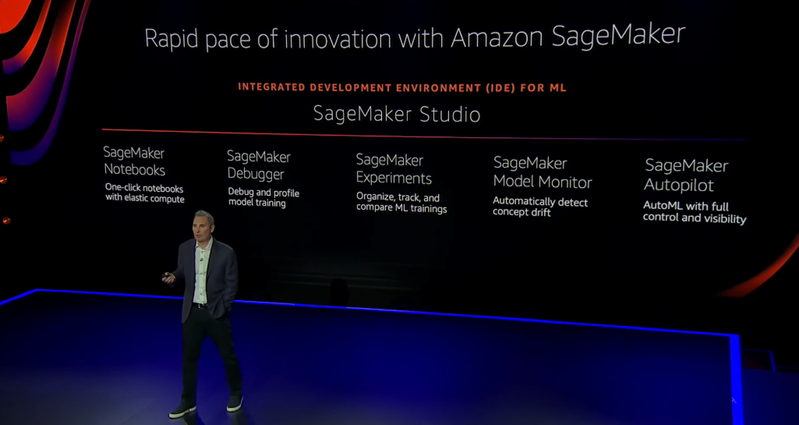
Data preparation is the next frontier, and it is hard. Take data from different sources, not normalized, many features. Example of a real estate app, need to do “feature engineering” to get the real data into the right format using conversions, transformations, queries, and so forth. Deal with missing data and outliers.
New SageMaker Data Wrangler to speed up data preparation. Point it at a data store, make use of over 300 built-in transformations, which are suggested automatically. Apply to entire data set, all infra managed under the covers.
Another challenge is dealing with features. Storing, saving, and reusing them is hard. Use the same features for training and to make predictions. New SageMaker Feature Store to make this a lot easier.
Yet another challenge is automation and orchestration. There’s no pervasive CI/CD solution. Amazon SageMaker Pipelines is data workflows for ML. Define steps, use built-in workflows, log steps to SageMaker Experiments, share & reuse workflows.
A lot of this is due to relentless innovation!
Customers want to do ML without creating models. They want to send data and get answers! Lots of AI services to do this — vision, speech, text, chatbots, personalization, forecasting, fraud, and development.
9:36 AM – Andy will go to Australia more often when he can do it on an Overture!
Reviewing this section, we see that data storage is definitely not boring!
And now on to machine learning with Marianna Tessel, CTO of Intuit:
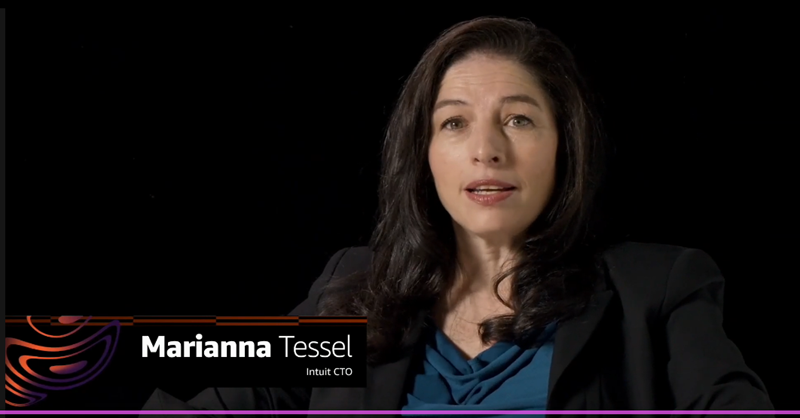
9:33 AM – Boom – building the first new supersonic airplane in many years. Founder Blake Scholl (ex-Amazon):
Using cloud computing to fly through actual clouds. Boom is making the world dramatically more accessible with supersonic flight (the Overture). 4.5 hours from Seattle to Tokyo (sign me up). Building the world’s fastest and most sustainable airliner.

Going all-in on AWS, saving them years of schedule and millions of dollars. XB-1 was designed on EC2 HPC clusters, tried hundreds of designs in simulated wind tunnels and got a 6-fold team productivity improvement. Moving 500+ TB of design and test data to AWS, using ML to calibrate wind tunnel results. Used 53 million core hours for XB-1, and expect to use 100 million for Overture.
Make the fastest flight also the most affordable.
I want one of these.
9:20 AM – Dealing with petabytes and exabytes of data using purpose-built databases. Use the right tool for the job.
Need to do the same thing for analytics tools. Challenge is data movement (or not). Tens of thousands of data lakes on Amazon Simple Storage Service (Amazon S3) that centralize data for ML and analytics. However, customers want to use this data in other ways and in other spots in a pervasive way. They want more freedom for their data.
AWS Glue Elastic Views to build materialized views across data stores.

9:17 AM – Babelfish to run SQL Server on Aurora PostgreSQL. New translation capability to complement Schema Conversion tool and AWS Database Migration Service (AWS DMS). Shed those expensive SQL Server licenses!

This is an open source project with the Apache 2 license, coming to GitHub in 2021.
9:14 AM – Moving on to databases, and how both Oracle and Microsoft are practicing short-term thinking.
Review of Amazon Aurora, customers are flocking to it, and still fastest-growing AWS service, with over 100K customers. This growth gives us tons of feedback (“fuel”, as he says).
Desire for serverless mode, which is why we built Aurora Serverless, which scales up (by doubling capacity) in 5 to 50 seconds. But customers want more features, and quicker + more precise scaling. Aurora Serverless v2 allows scaling to hundreds of thousands of TPS in a fraction of a second. MySQL now, and PostgreSQL in H1 2021.
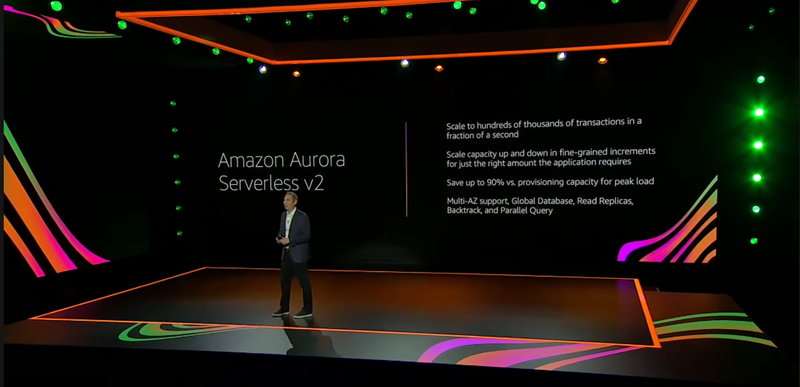
Would the old guard build this? No. We’re trying to build a business that will outlast all of us, be in it with our customers for the long haul.
9:08 AM – Reinventing storage, starting by reviewing pre-launch debate on whether Amazon Elastic Compute Cloud (Amazon EC2) could be launched without block storage. It could be, and it was, and EBS launched 2 years later.
gp2 storage is general purpose, but customers want to scale IOPS without scaling storage. The new gp3 volumes allow separate provisioning of each.

Some workloads need even more, around 200K IOPS and even more throughput. You can stripe but that’s hard.
New io2 Block Express, first SAN built for the cloud. 4x all dimensions of io2, including up to 64 TB volumes. More SAN features coming in 2021.
9:00 AM – Moving on to data and data sources.
Don MacAskill – CEO and Chief Geek at SmugMug. Very first big AWS customer.

Andy tells story of 6 TB incoming. Rudy Valdez (he and I once shared an office) relayed the message. Made clear that it was TB not GB (easy to confuse).
8:57 AM – Building apps from smaller and smaller parts, more and more changes. New deployment challenge, and AWS Proton will help!

8:53 AM – Moving on to serverless, hundreds of thousands of our customers use it.
We are changing the AWS Lambda billing increment from 100 ms to 1 ms.
140 AWS services can trigger Lambda functions.
Half of new apps built inside of Amazon are using Lambda!
Customers are using servers and containers together (is this peanut butter and chocolate?). Yes, Lambda Container Support! Package code and dependencies using existing container-based workflows.
8:50 AM – Moving on to containers, and AWS has three offerings – Amazon Elastic Kubernetes Service (Amazon EKS), Amazon Elastic Container Service (Amazon ECS), and AWS Fargate. Customers are making heavy use of all three, choosing the right tool for the job.
Customers still have containers that need to run on-premises, and want the same managment mechanisms that they have in the cloud.
Amazon ECS Anywhere – Run ECS in your own data center. Same APIs, management, and so forth.
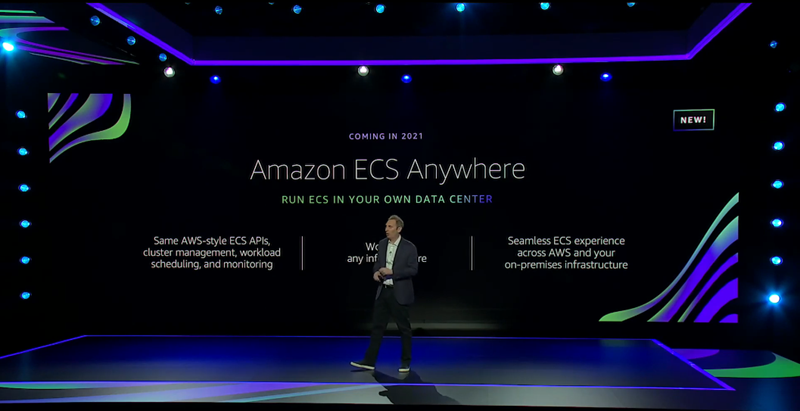
Amazon EKS Anywhere – Run EKS in your own data center, works alongside your on-premises apps and infrastructure.
Open Source of Amazon EKS distro.
8:40 AM – Andy is talking about areas that are being reinvented, while asking customers what they think.
Jerry Hunter, SVP of Snap (ex-Amazon) – Started with compute, Snap is a cloud native company, and first to adopt new technology. Plenty of room to innovate in compute.
Three modes: Instances, Containers, Serverless. All three are here to stay.
Instances – New D3en, New Mac1. Intel, AMD, and Arm chips. Lots of capabilities, innovating fast.

How do we do this?
Reinventing virtualization with AWS Nitro System, getting performance that’s indistinguishable from bare metal. Broke out components into separate cards or chips (reminiscent of our two-pizza team model that eschews dependencies).
Chips, deep relationships with Intel and AMD. Knew we had to build our own, acquired Annapurna a few years ago. Started with generalized compute, built Graviton for general purpose workloads.
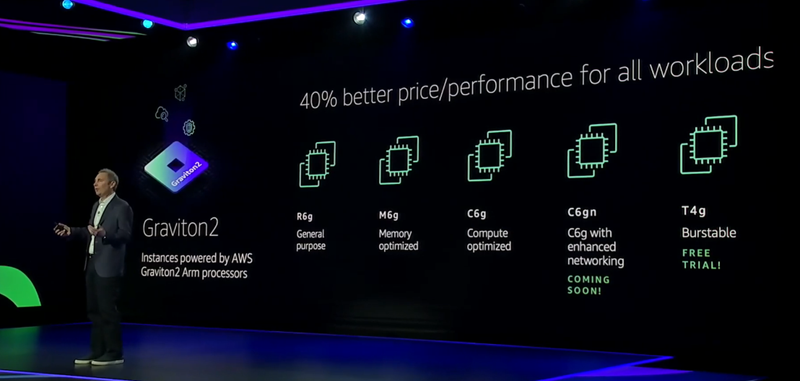
Delivers 40% better price performance, customers love it. Lot more coming in this space!
Today we are announcing the C6gn instance, ready in next week or two.
The Inf1 chip lowers cost of ML inferencing, helped Alexa to reduce cost of inference while also lowering latency.
Coming soon:
Habana Gaudi-based EC2 Instances – Built specifically for ML training, Intel chips. H1 2021.
AWS Trainium – New ML training chip, support all major frameworks and the Neuron SDK. H2 2021.
We are now reinventing instances every few months, not every few years.
8:31 AM – Lori Beer, CIO of JPMorgan Chase. Everything is at tremendous scale. Technology helps them to differentiate, dealing with technical change since the time of Thomas Edison. Today, driven by mobile computing. Rapid pace of change, disruption.
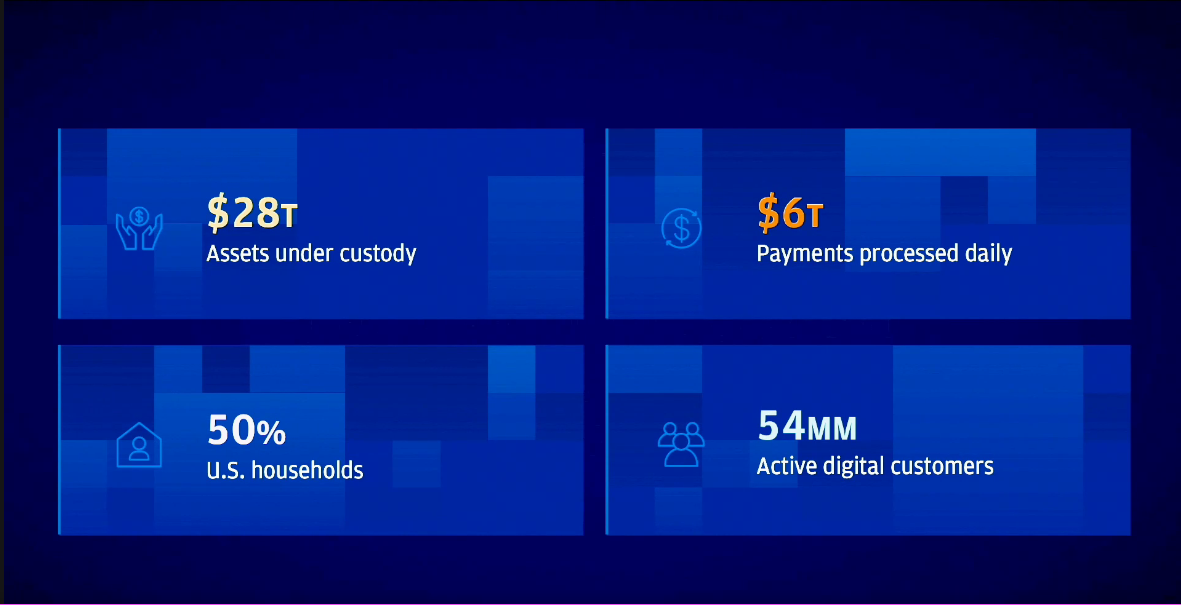
Leveraging AWS to refactor apps to be cloud native, leveraging AI/ML, while staying secure.
Holding hackathons in conjunction with AWS to better understand problems, then develop reusable blueprints. AWs lets them scale to massive volume. Amazon Elastic Kubernetes Service (Amazon EKS), AWS Lambda, Amazon EMR all let them innovate and stay ahead of their competitors. Migrating critical workloads and taking advantage of unique capabilities of the platform.
Use Amazon SageMaker to rapidly test and train ML algorithms, supporting real use cases that deliver real value. Investing in cloud data warehousing with Amazon Redshift, influenced by their ML success. Infusing analytics into everything they do.
Already seeing payoff in efficiency, agility, and security.
8:30 AM – AWS in the Gartner Magic Quadrant, we’ve been at this for 6 years more than anyone else.
8:20 AM – What does it take to reinvent?
- Leadership will to invent and reinvent. AirBnb, Peleton, Stripe — all huge amounts of invention. You have to be maniacal, relentless, and tenacious. You need to have the data, even if people inside might try to obfuscate it from you. You can’t fight gravity, and you have to have the courage to pick up and change. Netflix cannibalizing DVD rental business, or Amazon.
- Acknowledge that you can’t fight gravity. Amazon compared to eBay or Half, how do you serve customers? Build a marketplace, invite in third-party sellers.
- Talent that’s hungry to invent. New talent often more willing to rip up and rebuild, because existing talent possibly reluctant to do that to what they built.
- Solve real customer problems. Focus on customers, not on competitors or on products. Invent on behalf of customers instead of building stuff because it is cool.
- Speed. Matters at every stage of the business. Push back against claims of too risky. Speed is a choice, make it, set up a culture that has urgency and wants to experiment. Not a switch, must build the muscle. Now is the time.
- Don’t Complexify. Managing technologies while making big transformations and shifts. Choose a partner, get momentum, get success & results, add complexity later.
- Use platform with most capabilities & broadest set of tools. [[What’s a 5 iron??]] All of these things enable builders to create anything that they can imagine.
- Pull it all together with aggressive top-down goals. GE moving apps to AWS in 30 days (a while ago), seemed aggressive, CIO made them do it anyway. Almost done moving 9,000 apps to AWS in just 2 years. Similar story at Capital One. Avoid just dipping toe into the water.
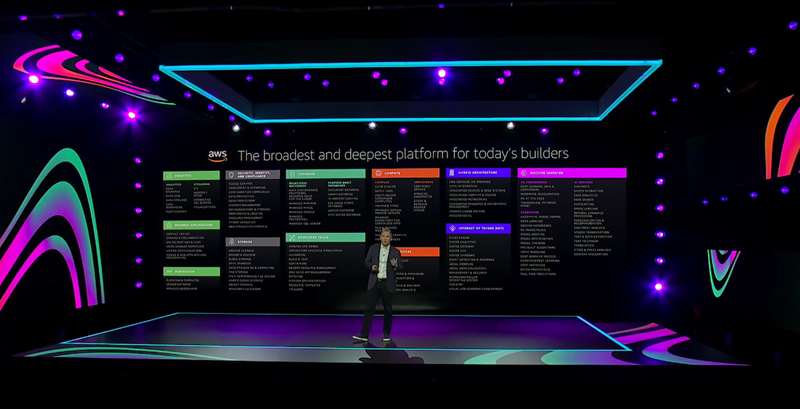
8:10 AM – There’s still a lot of growth ahead, with just 4% of total IT spending currently on the cloud. COVID-19 is pushing companies to the cloud. There’s less dipping of toes into the water and more action. Companies on the Fortune 500 don’t often last there, unless they reinvent themselves regularly. Better to do this early when you are healthy than in a moment of desperation. To do this you need the right culture and the right technology.
8:05 AM – Andy is on stage, and announced that over 500,000 people have registered for re:Invent. It will take place over the next 3 weeks. He’s explaining what it means to grow to a $46B annual run rate:
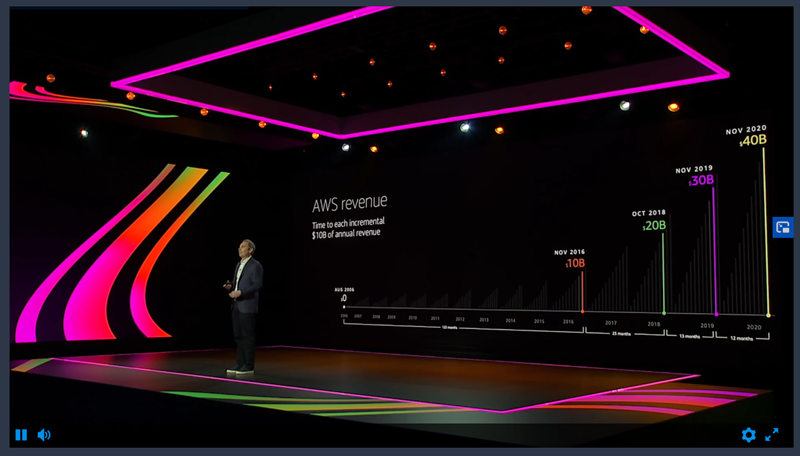
7:57 AM – You’ve been listening to Zach Person:

7:55 AM – We’re just about ready. Don’t forget to keep on refreshing this page so that you can read all of my updates!
7:50 AM – Are you ready to watch the keynote? I am! I had my first re:Invent briefing on October 1st and have been working on my content ever since. The teams have been doing their best to listen to customers, develop a deep understanding of their needs, and to build services and features that meet those needs. It is always an exciting and frenetic time, and there’s always 5x more work to be done than there’s time for.
7:45 AM – I’m sitting at my desk and ready to go, with a nice mocha and some fizzy water (two separate drinks) to get me going. In addition to doing this live blog, I will be tweeting links to my blog posts as soon as Andy makes the announcements, retweeting links to the posts written by the other AWS News bloggers, and participating in the online virtual audience for the keynote. I’m also preparing for a customer meeting right after the keynote and a video recording later in the day.
